Table of Contents
- Table of Contents
- Why you should create a personal website
- Purchasing a domain name
- Selecting a web host for your personal website
- Setting up WordPress
- Selecting a WordPress theme
- Installing base plugins for functionality
- Adding in your content to your personal website
- Publicize your new personal website
- Managing your personal website and content
- Use Portafoglio to create your personal website today!
Personal websites have suddenly become more popular with the realization that social media websites aren’t really forever.
And the good news is that creating a personal website for yourself has never been easier. You could even create your own website within an hour if you know what you’re doing ahead of time.
Having your own website is critical in today’s world. It’s going to be a place that you’re able to call home online. And you won’t have to worry about someone you don’t know making a bunch of bad decisions and quickly ruining the place where you post all of your pictures and videos.
So let’s dive into how you can create your own personal website today using WordPress and the Portafoglio theme (or really any WordPress theme for that matter). By the time you finish this article, you’ll know exactly what you have to do to build your new website!
Let’s get started!
Why you should create a personal website
So first off let’s go over why you should create a personal website. If you’ve already decided that you want to build a personal website, you can jump down to the next section.
But as we have seen time and time again, social media websites will come and go. It’s not just Twitter in late 2022. We also had MySpace in the 2000s and plenty of other ones have gone under over time.
Social media websites aren’t forever. But personal websites are … or at least they’re more permanent than social media.
Plus, your personal website really should be your digital home. Yes, you can obviously be on as many social media platforms as you want, but your website will always be your home online.
You can post links to your website on your social media profiles, like if you want to tell a story along with the photos from your latest vacation. And you can also embed your social media profiles on your website as well.
And finally, the best part about having a personal website is the fact that you control everything.
You can control what your website looks like. Want something that’s plain and minimalistic? You can create that. Want something that has more pizazz and sparkle? You’ll be able to do that with your own website.
You also can control the content on your website. Want to create an about page with a lot of photos of yourself? You can do that with no worries. You can also use your website to show off your favorite personal projects or even start selling something you might have started as a hobby.
Plus, if you really dive into the search engine optimization (SEO) game, you can get found in Google searches more easily.
Creating a personal website gives you so much more control than you ever have with a social media profile.
Purchasing a domain name
So the first thing you need to do to create your personal website is to purchase a domain name.
What is a domain name? To put it simply, a domain name is the string of characters that a user enters into their browser’s address bar to go to a website. The easy examples are facebook.com, google.com, twitter.com, etc.
Think of it this way, the domain is to your website what your physical address is to your home. It simply points to where your website is hosted so that the user can load up your site.
Now, I do want to point out that a domain name is different from web hosting. We’ll touch on web hosting in the next section, but that is where the files and database for your website live. Your domain then points to that location where your website is hosted, to make it as simple as possible.
As for what you should pick for your domain name, I would highly recommend trying to get your name. If you have a unique name, that should be pretty easy. Your only question is whether to go with dot com, dot me, dot blog or something else.
If your name is more common, you might need to get more creative with the domain name or pick a dot me, dot blog or other top level domain variant of your name.
To purchase a domain, you can use a service like Name.com, Namecheap or Hover.
But definitely take some time to think about what your domain name is going to be before you purchase it. You only get one shot at this.
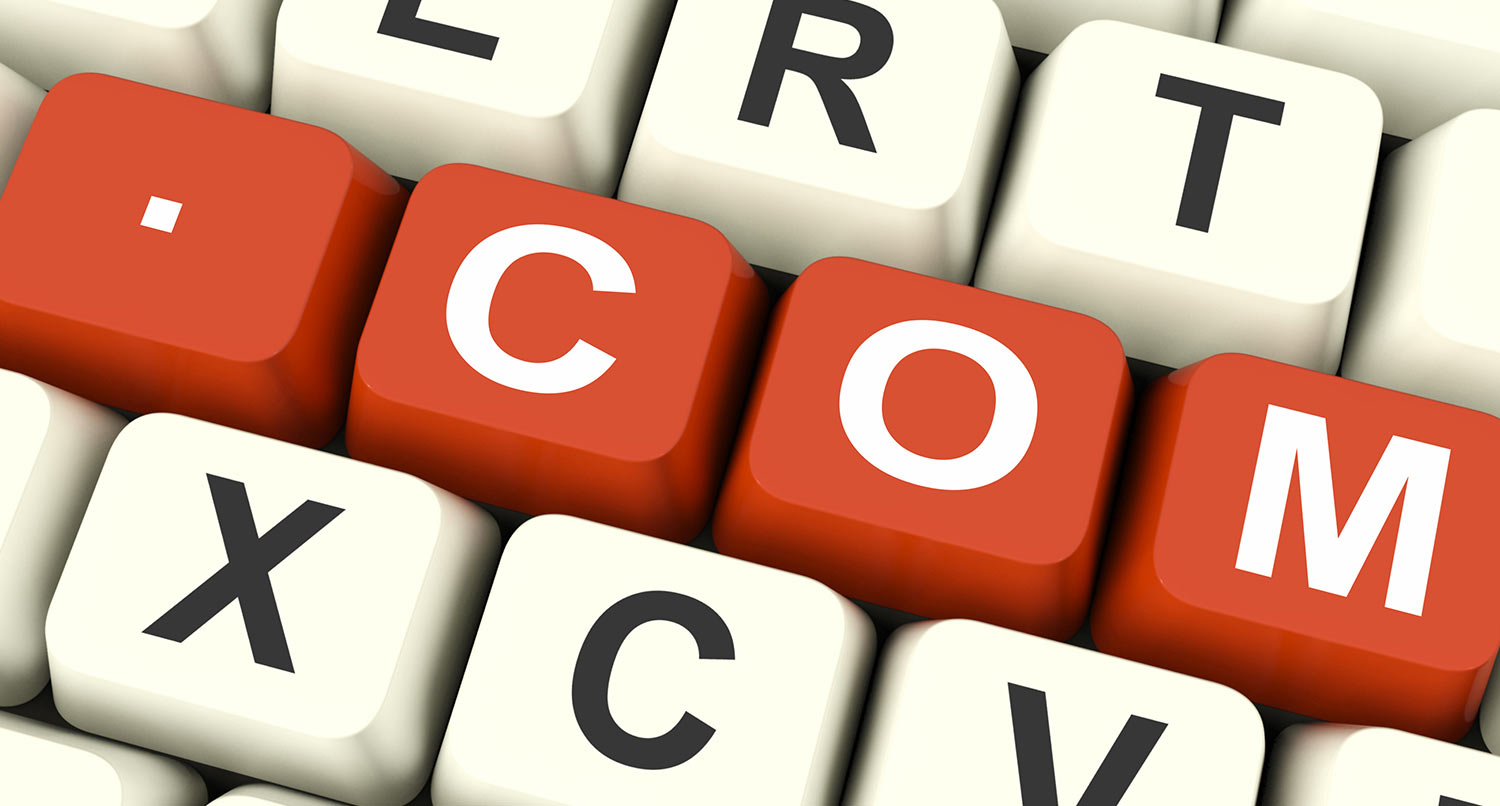
The guide to buying the perfect domain name
Domain names are one of the most important parts of creating a website. Here’s how to pick the perfect name for your new website.
Selecting a web host for your personal website
The next step for creating your personal website is to pick a web host for your WordPress website. Like I mentioned before, this is where the files and database for your website will live.
The good news is that you have a lot of really good options here. And since you don’t need any super fancy hosting since you’re probably not going to be expecting millions of visitors (at least right now) and you’re probably not going to be selling a whole lot of products.
In this regard, I highly recommend checking out Siteground, Pressable and Inmotion Hosting. All three of these companies are great, and I’ve never had an issue with them before. And they should all have relatively cheap hosting for the level of service they provide you. I don’t think you can go wrong with any of them.
If you want to take a deeper dive into the best web hosting companies for WordPress, you can check out the blog post I wrote on it.
Setting up WordPress
Now we get to the really fun part about creating a personal website: actually building it.
So with WordPress today, a lot of web hosts have either a one-click install for WordPress or will spin up your WordPress website for you when you sign up.
Once your website is created, you should first get familiar with the dashboard. It’s pretty simple now, but it can get a bit overwhelming once you start adding in plugins.
Going through the settings
Next, you should go through the site settings, which can be found under the “Settings” menu item in the left-hand menu in the dashboard.
The first section is the general settings where you can update your site title, the administration email, your date and time settings. Just a heads up, for the timezone setting, use the city-based time zones and the UTC time zones.

The next section is the writing settings which primarily focus on setting up writing and publishing posts by email, which honestly is not a great idea.
The next section beneath that is the reading settings where you can set up what page is your home page, what page shows your blog posts (if the theme you’re using doesn’t have a blog page template) and whether or not search engines can index your website or not. You should have this setting checked while you’re building your website and then uncheck it when your website goes live. If you don’t see your website in search results, come back here to make sure you don’t still have it checked.

The next section is the discussion settings which control comments on your website. The media settings in the next section deal with images and how they are uploaded to your website.
Next up is the permalinks settings, and these are really important. These settings will set up the URL for all of your posts and pages for your website. And once you’ve set them, you can’t really change them because you’ll cause a lot of 404 errors if people try to go back to the old URLs and search engines will definitely not like your website.
So you need to choose your permalink structure carefully. I highly recommend going with either post name or a /%category%/%postname%/ permalink.
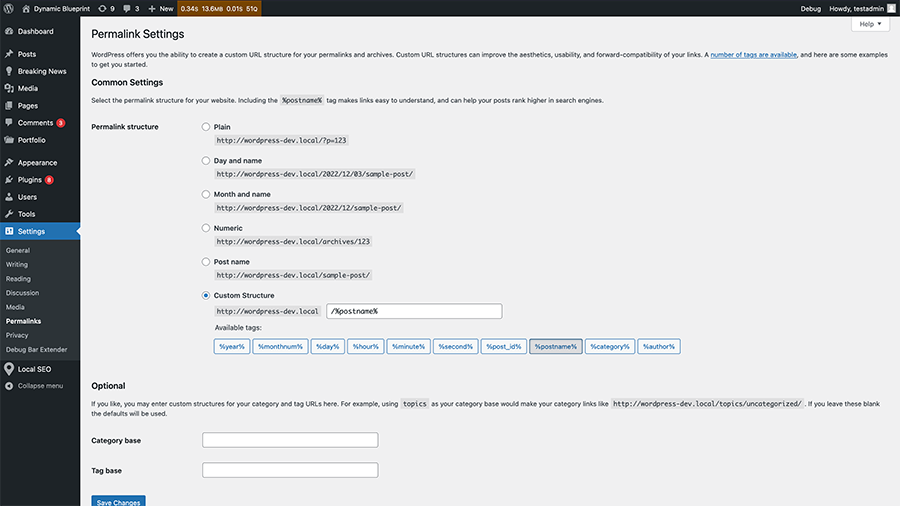
Finally, the last section is the privacy settings where you can create a privacy policy page for your website, which I highly recommend.
And now you’re really ready to begin building and customizing your personal website.
Selecting a WordPress theme
One of the best parts about WordPress are the number of themes – both free and paid – that you can use to give your website a unique look and feel.
There is the free WordPress Theme Directory that hosts over 10,000 themes for you to choose from. You can also look for premium themes over on Themeforest, MOJO Marketplace and other market places.
There are a few things to look out for when choosing what theme you want for your website.
First, make sure that it has a good design and that it reflects who you are. Make sure that all of the important parts, like the navigation, the content, the footer text, etc., are all readable and usable. And make sure that you like the theme (duh).
Second, make sure that it’s still being developed. If you choose a theme that is no longer supported, at best you’ll get a theme where the bugs will never get fixed and at worst you might be using a theme that’s a security risk. So make sure that it’s been updated recently.
Third, check to make sure that it’s accessible. You can use the WAVE browser tool to test the theme demo for accessibility. If there are a ton of errors when you check it, you should avoid it. You want everyone to be able to use your website no matter what technology they use to browse the web.
Finally, just try out the theme demo as much as possible to make sure that it’s something you want for your website before you purchase and/or download it.
Why you should choose Portafoglio
On the theme front, I’ve released a paid WordPress theme, Portafoglio, that works for a portfolio website or a personal website.
This theme is a block theme, which means you can customize every part of your website without touching any code – from the header and footer to the various templates. You can change the colors that are used to match your personal color scheme, the way your pages look, the way your blog posts look and so much more.
There are also a ton of block patterns that you can use to create an awesome homepage to show who you are. And there’s a portfolio project custom post type that you can use to show your best projects or you can use as photo galleries for your life adventures.
If you’re trying to find a theme to help you create your personal website, take a look at Portafoglio.
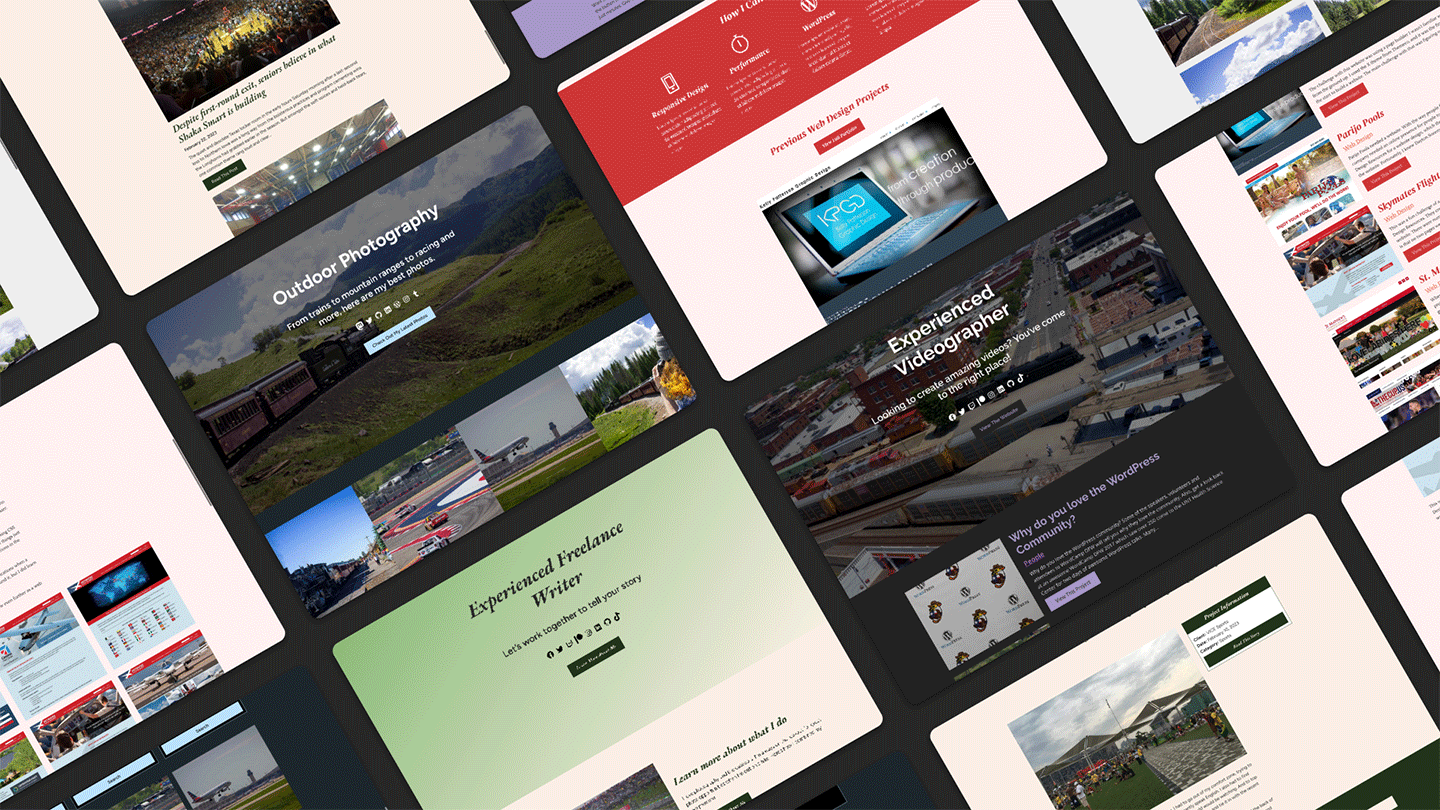
Portafoglio
Portafoglio makes it easy for you to create a portfolio website that shows off your amazing projects. This WordPress portfolio theme comes with a portfolio project custom post type to showcase your best work, many block patterns to create awesome pages and works with WordPress’ full site editing features to allow you to customize every…
Installing base plugins for functionality
The next step in creating your personal website is to add in some plugins to add extra functionality for your site.
To make a long story short, plugins are packages of code that add extra functionality to your website. With WordPress plugins, you can turn your website into an online store, a membership website and basically anything else.
But for now we’re just going to add in four plugins to add in functionality you will need no matter what you want to do with your website.
The first plugin is the Yoast SEO plugin. This will help your website’s technical SEO so that you have a better chance of getting found in Google searches. And it comes with tools in the post editor that can help you write better for both people and search engines.
The second plugin is Wordfence for security. There is a paid and free version of the plugin. The free version should be enough for your website. It will provide a firewall to protect your website from outside attacks. And it’s been great to use to feel good about my website’s security.
The third plugin is either Gravity Forms (which is paid) or WPForms Lite (which is free) for being able to create contact forms on your website or any other type of forms (like forms for lead generation for a service). Gravity Forms is a great option, but it does cost $59 per year for a license. If you’re looking for something free, WPForms Lite is a great option to use.
Finally, the last plugin is the Google Site Kit plugin. This plugin makes it super easy to connect your website to Google Analytics and Google Search Console, so that you can see stats about your website. We’ll get into this later once we launch the website, but all you’ll need to do is click some buttons and you’ll be good to go. There’s no need to worry about any code.
Adding in your content to your personal website
Now that you’ve added in your chosen theme and installed the plugins you need for the website, it’s time for the most important part of creating your personal website: the content.
What you add for content is ultimately up to you. But here are three pages that you have to have on your website no matter what.
Creating a homepage
The most important page on your website is your homepage. It’s what people are most likely going to see when they land on your site. So it’s worth taking some time to think about what you want on your homepage.
And the good news is that with the block editor and full site editing in WordPress, it’s pretty easy to create a completely custom homepage that matches your style.
For your website, you’ll at least want to have a “hero section” with a headline and descriptive text that welcomes a reader to your website and invites them to read more. You can even put links to your social media profiles here or add in a call to action button to take them to another page.
You’ll also want a brief introductory paragraph about who you are as well as a link to your about page. You can put a photo of yourself here if you want to.
Finally, if you have any portfolio projects that you want to show off, the homepage is a great place to show off your best work with a link to your full portfolio. And don’t forget to list your latest blog posts on the homepage as well and link to your blog.
But at the end of the day, make it your own. A lot of the block themes these days have patterns that can make creating this page super easy. So play around with it and find what works for you.
Creating an about page
The next most important page is your about page. This is your chance to tell your story.
Use this page to talk about what you’re interested in, how you got to this point in life and ultimately what makes you, well, you.
I know that writing about yourself can be a challenge, but really take some time to craft your life’s story into words. Plus, you can include photos from various points in your life and even embed video if that helps you create a better about page.
And again, make it unique to who you are.
Creating a contact page
The last important page you need to have on your personal website is a contact page. This is how people can find and contact you outside of your website, if you want them to.
This is a great place to have another set of links to your social media profiles for people to follow you there.
If you wanted to you could also put your email address and even phone number if you’re brave enough.
If not, you can create a “Contact Me” form using the form builder plugin you installed earlier and embed that form on this page. That way people can get into contact with you, but you don’t have to worry about exposing your email address to the world.
But do make sure that people have a way to get in contact with you through your website.
Publicize your new personal website
Now that you’ve set up your website with your theme and plugins and added in your content, it’s time for the last step in creating your personal website: take it live!
This step will really depend on what web host you’re using for your site. For some web hosts, you might have created your website using your domain name that you picked out in the first step. If that’s the case, all you need to do is make sure that you are allowing search engines to index your website (under the “Reading” settings) and to publish your URL on social media.
If you built your personal website with a temporary domain (for example, WP Engine starts you with sitename.wpengine.com), then you’re going to have to follow their steps for changing the URL to be your domain name. They should each have guides on how to do this or you can reach out to support for help.
But once it’s live be sure to let people know about it. Post about on your social media profiles. Include it on business cards if you want. Make sure to add it to your email signature.
Also, you can use the Google Site Kit plugin to hook your website to Google Analytics and Google Search Console. It will walk you through all of the steps to get started. And once you finish, be sure to go to your Google Search Console and add your website’s sitemap to Google to be indexed. You can learn more about how to do that with this blog post.
And whenever you publish a new blog post, be sure to post about it on your social media profiles.
How to share your website and blog posts to your social profiles
You will probably want to set something up to publish your new blog post to your social media channels automatically when you hit publish. That way you don’t have to worry about forgetting.
There are a number of ways you can do this for your website. The easiest is to use the Jetpack Social plugin which will automatically post to your Twitter, Facebook, LinkedIn and Tumblr profiles when you hit publish.
Another really good option is the Social Media Auto Publish plugin, which also allows you to publish to Instagram as well. That might be beneficial if you love taking great photos.
But do make sure to let people know when you’ve published new content on your website!
Managing your personal website and content
So now that you launched your personal website and shared it with the world, you’re done with the website outside of creating new blog posts, right?
Wrong.
In addition to new blog posts and adding new images from your adventures in life, there are other things you need to regularly do on your website to keep it up and running.
Let’s take a look at the big ones.
Update your website
With WordPress for your personal website is also going to come updates for your plugins and themes and even WordPress core itself.
These updates can be crucial for your website. Some updates will contain security patches that can protect your website from bad actors trying to attack it. Others will contain bug fixes that will remove headaches for you. And some updates will include cool new features that allow you to do amazing things with your website.
So be sure to take time at least once a week to update your website’s plugins and themes and run any WordPress core updates. If you need help in creating a plan on how to update your website, you can check out the video I created below on just how to do that.
Also, make sure that you’re updating the content on your website as well, especially the homepage, about page and contact page. If something changes, make sure the correct information is reflected on your website.
Be careful with your images
Something else you need to keep in mind as you use your personal website and add more content is being careful with the sizes of the images that you’re uploading.
That photo you took with your phone and want to upload to your website to show is going to be well over one megabyte (1 MB). And that’s problematic for two reasons. First, a bunch of large images are going to put strain on your website and cause performance issues. Second, someone trying to view your website on a not-so-great internet connection (like on their phone outside of a city), will have a very hard time getting to see that image.
So for any images you want to add to your website, you’ll need to use Photoshop or some other photo editing software to make the image smaller and compress it. A good number to shoot for would be 500 kilobytes (500 kb).
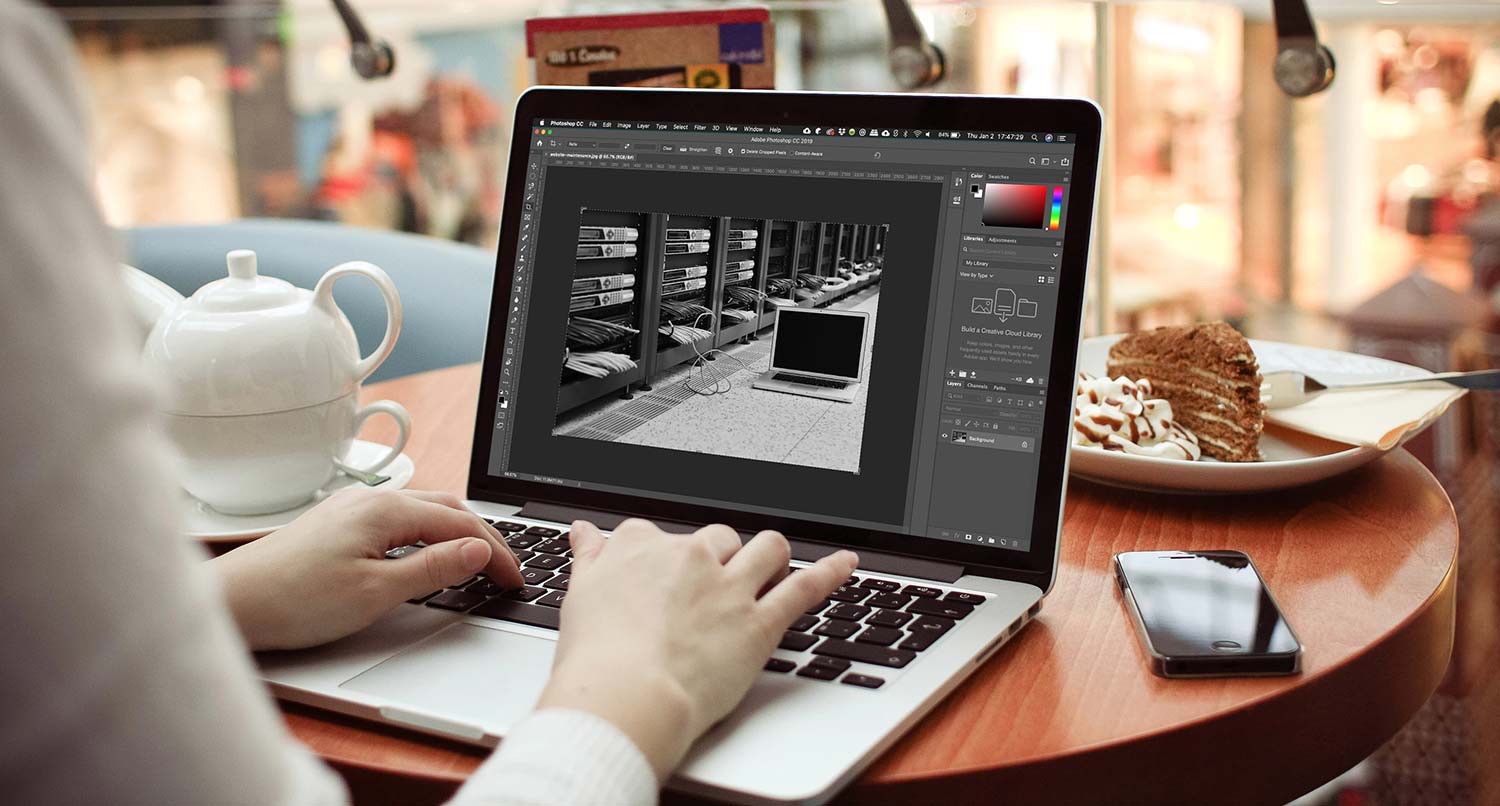
Compressing images for your website
Have you ever tried to load a page with large images? It’s frustrating. Make sure your site’s images are compressed to keep you pages loading quickly.
Also, make sure you add alternative text for your images when you upload them for screen readers and search engines. WordPress makes this very easy to do right in the media manager.
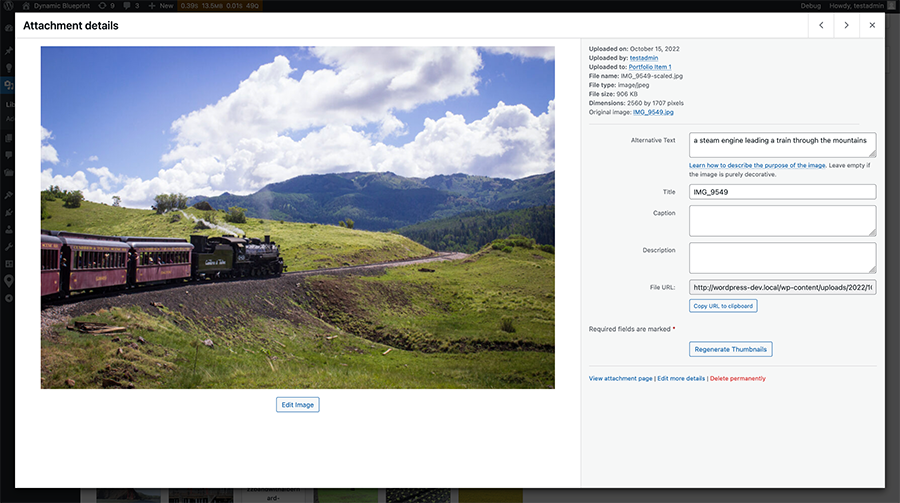
Use categories to organize your posts
Another thing you’re going to want to do with your personal website is to use categories to sort your blog posts.
WordPress gives you categories and tags to organize your blog posts. Categories are the most important of the two.
For categories, you want to think about them as buckets that you place your posts into. Ideally, posts should go into just one bucket or category, unless one of the categories is a “featured”-type category that you use to show posts on your homepage. In that case, a post can be in two categories.
You can then use these categories to sort your posts into sections like “Travel” or “Food” or whatever you want. And your users can view only your “Travel” blog posts if they want.
So before things get too crazy with your blog, go ahead and create the categories you think you’ll need for your website. And don’t worry, you can add more categories as you go along.
Don’t go crazy with your plugins
Finally, you need to be careful with the plugins that you add to your personal website.
It can be very easy in WordPress to add a ton of plugins to your website. But that can have a negative impact on your website. More plugins means more code that has to run when the website is loaded which can hamper your website’s performance.
Also, more plugins can mean more security vulnerabilities for your website.
So make sure that you only add the plugins that you absolutely need for your website. If you suddenly find yourself with over 25 plugins, take a look at all of them and really see if you need each of them. Then remove the ones you don’t need.
Just because you can add as many plugins to your website doesn’t mean you should.
Use Portafoglio to create your personal website today!
Are you ready to create your own personal website today? Trying to figure out what WordPress theme will work the best for your new website? Take a look at the Portafoglio Portfolio WordPress theme today!
Portafoglio is built to be the perfect personal or portfolio website theme. There are a number of various block patterns that allow you to create cool pages that will attract attention. You can easily create new blog posts to keep your followers updated. And it comes with a portfolio project custom post type which is perfect for showing off your great projects or just showing off your favorite photos.
Check out Portafoglio and get started on creating your amazing personal website today!

